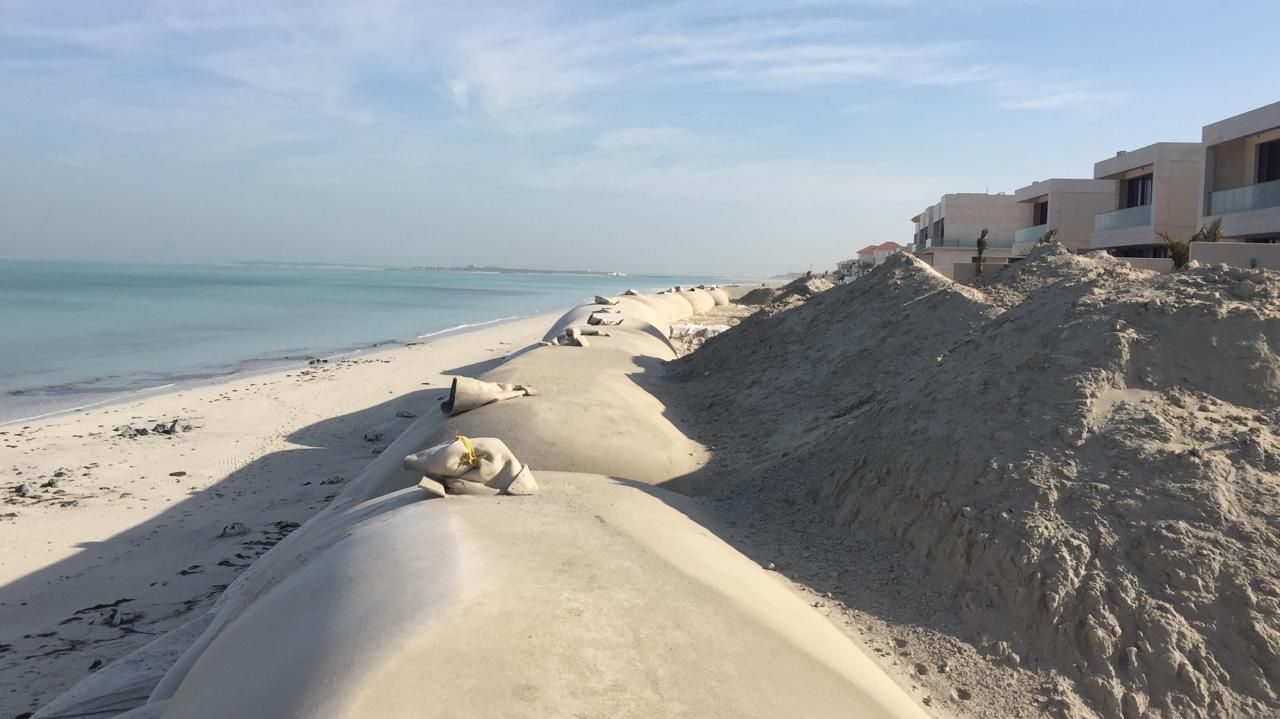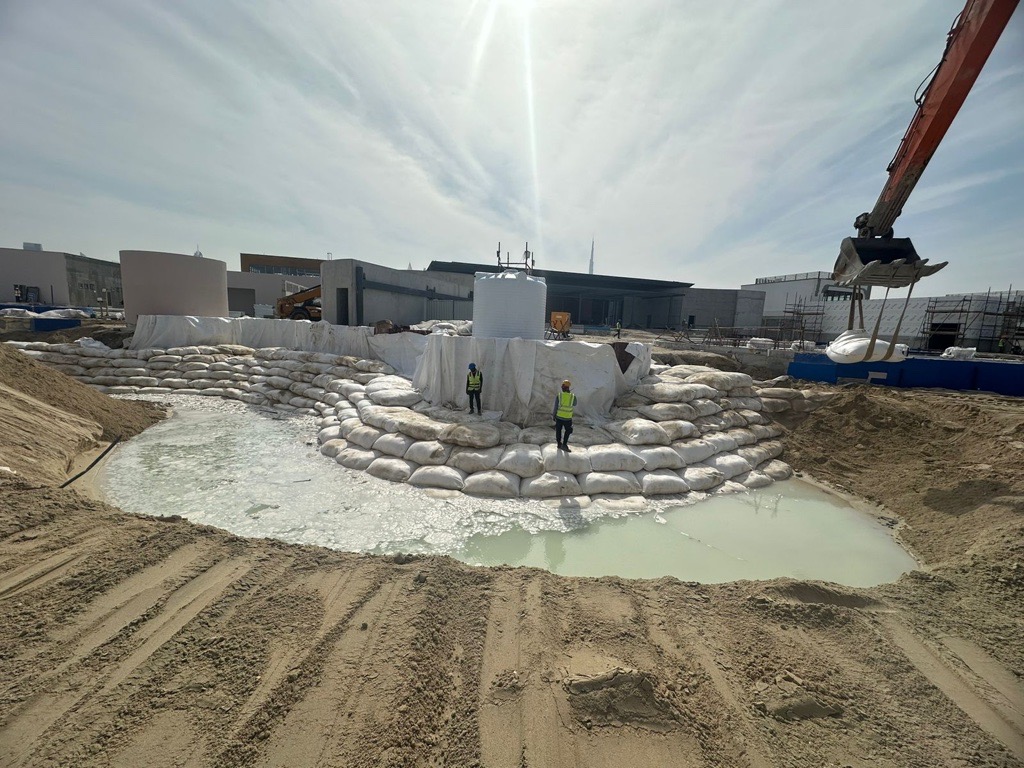
Over the last few years, weather patterns around the world have shifted. We see violent storms becoming increasingly frequent. Coupled with the risk of rising sea levels and erosion, especially on sand-based islands, the need for coastal protection is fast approaching the ‘must-have’ status. For more insights on this global challenge, refer to our previous blog post on coastal erosion.
This is where geosynthetic containers come in. They are also known as GSCs, geotextile tubes and bags, geotubes and geobags, or coastal protection containers. Billed as an alternative solution for coastal protection or temporary marine structures, the containers are manufactured from geotextile materials and filled with sand. This creates durable and long-lasting barriers against rough marine environments and inclement weather.
Geosynthetic containers are three-dimensional systems that provide stable and effective coastal protection. They are low impact, both environmentally and visually. These systems are not sandbags or bulker bags, as is commonly misunderstood. They require a precision-engineered approach for installation. The containers come in a variety of sizes, ranging from 600 kilograms up to in excess of 650 tonnes within our range. This weight provides stability. It allows for projects to be designed and constructed in high wave energy coastal areas. Waves in these areas can reach more than 12 meters in height.
Hidden revetments: We commonly use these when constructing artificial islands. The tubes are used to ensure there is no erosion beyond a certain point on the beach. The revetments are buried in the sand. They are not visible above the ground.
Groynes or the core of breakwaters: In this application, the tubes form the core of the structure. Once filled with sand and installed in place, they are covered with a layer of geotextile and rocks of varying sizes.
Artificial reefs: Coastal protection tubes installed on the seabed form a key part of coastal protection plans. They dissipate and break up wave energy. This improves the stability and longevity of the coast due to the lower wave energy.
Furthermore, these geotextile structures encourage the growth and diversity of marine life. They particularly benefit soft corals and kelp. Thus, they significantly enhance the local marine ecosystem.
Our in-house engineered Coastal Protection Containers have served several projects worldwide. These projects include hospitality venues such as the Hilton Abu Dhabi, Sheraton Jumeirah Beach Resort and the Fairmont Ajman in the United Arab Emirates (UAE). Other projects include the Red Sea Marine Life Institute in Saudi Arabia, Jangwani Beach in Tanzania, and many more.
Recently, our Ecobag Coastal Protection Containers were deployed for the La Mer redevelopment project in Dubai, the UAE. Filled with locally sourced sand, these containers provide a sustainable solution for coastal defense. They ensure the longevity and safety of the infrastructure. While we did not perform the installation, our containers effectively protected the structures from the waters of the Persian Gulf.

Using geosynthetic containers has proven to be a more cost-effective alternative on projects where rocks are not readily available. On such projects, the transportation of rocks from quarries via trucks or barges drastically increases costs. However, with geosynthetic containers and the ease of availability of local sand, we minimize costs, time wasted, logistics and other associated expenses.
In addition, since we can easily customize the size and dimensions of GSCs, they offer greater flexibility compared to rock-based structures. This also has several environmental benefits. The footprint of GSC structures is often smaller than rock-based ones. Additionally, it causes less disruption to delicate marine ecosystems. Once the structures have fulfilled their purpose, we can repurpose the sand. This reduces material wastage. Our geotextiles are biodegradable, making them the eco-friendly option.
Last but not least, Ecocoast’s calculator, Geoforce, provides an additional benefit. The calculator’s function is to verify whether a certain type of geobag or geotube can withstand the environmental conditions of the installation site.
We use Geoforce to confirm the stability of different structures made from GSCs, such as groynes, revetments, breakwaters and causeways. The calculator is highly customizable. It can incorporate GSCs of any size made from both woven and non-woven geotextiles. Depending on the input parameters, the calculator generates results. These results verify whether the defined structure is stable under the wave and current condition provided.
The calculator can also add a layer of armour rocks on top of the GSC structure. It can run calculations to identify the nominal diameter of the rocks to be used in the area.
Explore how our coastal protection containers can provide a durable and sustainable solution for your projects. Contact us today for more information.
Geosynthetics as alternative solution for coastal protection
Coastal protection on Saadiyat Island using geosynthetics
Geosynthetics for flood protection structures
Geosynthetic containers (GSCs) are used in a variety of coastal protection applications, including:
Unlike traditional sandbags or bulker bags, geosynthetic containers are precision-engineered systems made from high-performance geotextiles. They are available in sizes ranging from 600 kilograms to over 650 tonnes, making them suitable for use in high-energy coastal environments. These containers are not temporary fixes but durable, long-term solutions designed specifically for coastal and marine applications. Their design, material quality and installation methods distinguish them significantly from conventional alternatives.
Geosynthetic containers provide effective coastal protection by forming stable, long-lasting barriers that dissipate wave energy and minimize erosion. They can be used to reinforce beach structures, form the base of groynes and breakwaters, or be deployed on the seabed to function as artificial reefs. Their high mass and engineered design make them suitable for withstanding extreme marine conditions, helping maintain the integrity of coastlines and nearby infrastructure.
Geosynthetic containers offer a more cost-effective alternative to traditional rock structures, especially in regions where rocks are not readily available. Using locally sourced sand to fill the containers eliminates the need for expensive rock transportation, significantly reducing logistical costs and project timelines. Additionally, their lightweight and modular design makes them easier to handle and install, contributing to further savings in time and labor.
Yes, geosynthetic containers are engineered to perform in high wave energy environments. Some of the containers in Ecocoast's range exceed 650 tonnes in weight, providing the mass and stability required to endure waves taller than 12 meters. Their robust construction and adaptability make them ideal for deployment in challenging marine conditions.
The use of geosynthetic containers brings several environmental advantages. Their installation typically has a smaller ecological footprint compared to rock structures and causes less disruption to marine ecosystems. These containers also encourage marine biodiversity, supporting species like soft corals and kelp. Moreover, once their structural role is complete, the sand inside can be repurposed, and the biodegradable geotextile materials used help reduce long-term environmental impact.
Yes, geosynthetic containers can be highly customized to meet the specific needs of different coastal protection projects. They are available in a wide range of sizes, from smaller 600-kilogram units to massive containers exceeding 650 tonnes. This flexibility allows engineers to design structures that are tailored to the wave energy, environmental conditions and functional requirements of each site. Whether used in high wave energy zones or for specific applications like groynes, breakwaters, or artificial reefs, these containers can be adapted in both size and material composition, such as woven or non-woven geotextiles.